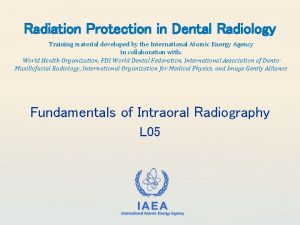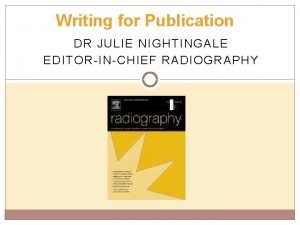Radiography Dentalelle Tutoring Emulsion The emulsion consists of







- Slides: 7

Radiography Dentalelle Tutoring

Emulsion The emulsion consists of gelatin containing microscopic, radiation sensitive silver halide crystals, such as silver bromide and silver chloride. When x-rays, gamma rays or light rays strike the crystals or grains, some of the Br- ions are liberated and captured by the Ag+ ions. In this condition, the radiograph is said to contain a latent (hidden) image because the change in the grains is virtually undetectable, but the exposed grains are now more sensitive to reaction with the developer. When the film is processed, it is exposed to several different chemicals solutions for controlled periods of time. Processing film basically involves the following five steps…

Processing Film Development - The developing agent gives up electrons to convert the silver halide grains to metallic silver. Grains that have been exposed to the radiation develop more rapidly, but given enough time the developer will convert all the silver ions into silver metal. Proper temperature control is needed to convert exposed grains to pure silver while keeping unexposed grains as silver halide crystals. Stopping the development - The stop bath simply stops the development process by diluting and washing the developer away with water. Fixing - Unexposed silver halide crystals are removed by the fixing bath. The fixer dissolves only silver halide crystals, leaving the silver metal behind. Washing - The film is washed with water to remove all the processing chemicals. Drying - The film is dried for viewing.

Manual processing begins with the darkroom. The darkroom should be located in a central location, adjacent to the reading room and a reasonable distance from the exposure area. For portability, darkrooms are often mounted on pickups or trailers. Darkrooms Film should be located in a light, tight compartment, which is most often a metal bin that is used to store and protect the film. An area next to the film bin that is dry and free of dust and dirt should be used to load and unload the film. Another area, the wet side, should be used to process the film. This method protects the film from any water or chemicals that may be located on the surface of the wet side. Each of step in the film processing must be excited properly to develop the image, wash out residual processing chemicals, and to provide adequate shelf life of the radiograph. The objective of processing is two fold: first, to produce a radiograph adequate for viewing, and second, to prepare the radiograph for archival storage. Radiographs are often stored for 20 years or more as a record of the inspection.

The automatic processor is the essential piece of equipment in every x-ray department. The automatic processor will reduce film processing time when compared to manual development by a factor of four. To monitor the performance of a processor, apart from optimum temperature and mechanical checks, chemical and sensitometric checks should be performed for developer and fixer. Chemical checks involve measuring the p. H values of the developer and fixer as well as both replenishers. Automatic Processor Also, the specific gravity and fixer silver levels must be measured. Ideally, p. H should be measured daily and it is important to record these measurements, as regular logging provides very useful information. The daily measurements of p. H values for the developer and fixer can then be plotted to observe the trend of variations in these values compared to the normal p. H operating levels to identify problems. Sensitometric checks may be carried out to evaluate if the performance of films in the automatic processors is being maximized. These checks involve measurement of basic fog level, speed and average gradient made at 1° C intervals of temperature. The range of temperature measurement depends on the type of chemistry in use, whether cold or hot developer. These three measurements: fog level, speed, and average gradient, should then be plotted against temperature and compared with the manufacturer's supplied figures.

Viewing Radiographs (developed film exposed to x-ray or gamma radiation) are generally viewed on a light-box. However, it is becoming increasingly common to digitize radiographs and view them on a high resolution monitor. Proper viewing conditions are very important when interpreting a radiograph. The viewing conditions can enhance or degrade the subtle details of radiographs.

Film viewers should be clean and in good working condition. There are four groups of film viewers. These include strip viewers, area viewers, spot viewers, and a combination of spot and area viewers. Film viewers should provide a source of defused, adjustable, and relativity cool light as heat from viewers can cause distortion of the radiograph. A film having a measured density of 2. 0 will allow only 1% of the incident light to pass. A film containing a density of 4. 0 will allow only 0. 01% of the incident light to pass. With such low levels of light passing through the radiograph, the delivery of a good light source is important. Viewing The radiographic process should be performed in accordance with a written procedure or code, or as required by contractual documents. The required documents should be available in the viewing area and referenced as necessary when evaluating components. Radiographic film quality and acceptability, as required by the procedure, should first be determined. It should be verified that the radiograph was produced to the correct density on the required film type, and that it contains the correct identification information. It should also be verified that the proper image quality indicator was used and that the required sensitivity level was met. Next, the radiograph should be checked to ensure that it does not contain processing and handling artifacts that could mask discontinuities or other details of interest. The technician should develop a standard process for evaluating the radiographs so that details are not overlooked.













